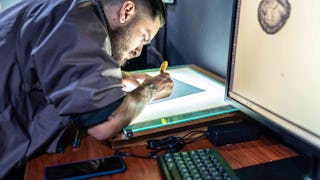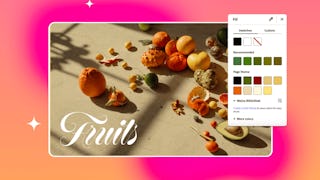Graphic Design is all around us! Words and pictures—the building blocks of graphic design—are the elements that carry the majority of the content in both the digital world and the printed world. As graphic design becomes more visible and prevalent in our lives, graphic design as a practice becomes more important in our culture.

Gain next-level skills with Coursera Plus for $199 (regularly $399). Save now.

Fundamentals of Graphic Design
This course is part of Graphic Design Specialization

Instructor: Michael Worthington
875,612 already enrolled
Included with
(18,305 reviews)
What you'll learn
Implement the fundamentals of color: visual, rhythm, and pattern in design
Use scale, weight, direction, texture, and space in a composition
Typeset text and experiment with letter forms
Create your own series of images using different image making techniques
Skills you'll gain
Details to know

Add to your LinkedIn profile
See how employees at top companies are mastering in-demand skills

Build your subject-matter expertise
- Learn new concepts from industry experts
- Gain a foundational understanding of a subject or tool
- Develop job-relevant skills with hands-on projects
- Earn a shareable career certificate

There are 6 modules in this course
Welcome! In this first module I will summarize the assignments and expectations of this course.
What's included
1 video4 readings
This week we are going to look at how images function in terms of conveying denotative and connotative messages, I'll show you a range of analog and digital imagemaking techniques and discuss how they work. In the first peer review assignment you'll create your own series of images, experimenting with formal techniques. Later, you'll have the opportunity to rework those images to enhance their ability to communicate an idea through connotation in an optional assignment: give it a try, it'll help you develop your communication skills as well as your formal skills!
What's included
12 videos4 assignments
This week we are going to look at typographic terminology and the basic rules for creating typography. I'll show you a range of tips and techniques for working with type, in both a functional and expressive manner, and you'll find out about the process involved in making and controlling typography. This week you'll complete a quiz to make sure you understand the language of typography–this is required. I also highly recommend you complete the two optional peer review assignments. In the first assignment you'll create your own typographic monogram, and you'll use that as a central element in designing a typographic business card in the second assignment. Give them a try, they are the place where you can demonstrate and apply your formal skills, and the place where you get to play with type!
What's included
12 videos3 assignments
This week we are going to look at how designers work with shape and color as their fundamental building blocks. You'll learn about visual contrast, color, rhythm and pattern in design. I'll be showing you the process involved in making an abstract design from shapes, and how to use that element to create a repeating pattern design. You'll be completing a quiz (required!) to make sure you understand how visual contrast and color work, and I also highly recommend you complete the two optional peer review assignments. In the first assignment you'll create your own simple and complex design motifs, and you'll use them as the central elements in designing a repeating pattern in the second assignment. The assignments are optional, but they are the place where you get to demonstrate and apply your formal skills, so well worth taking the extra time to complete!
What's included
10 videos1 reading2 assignments
This week we are going to look at how designers work with visual contrasts, cropping, hierarchy and direction in single images and complex compositions. You'll find out how to control and use scale, weight, direction, texture, and space in a composition, and how to compose work that ranges from the complex to the minimal. In the first peer review assignment you'll create your own abstract compositions that demonstrate your knowledge and control of visual contrast. In the final optional assignment, you can use all your skills from the entire course to create experimental compositions in the form of a poster for a mythical band. This last project is optional, but I strongly suggest you try it out, it'll let you grow and apply your design knowledge and really enjoy and express yourself in your design work!
What's included
10 videos2 readings1 assignment
In this section we've provided some useful resources for students wishing to further their studies in graphic design. The information was authored by Calvin Rye, MFA alumnus of the Graphic Design program at CalArts in consultation with CalArts' Graphic Design faculty and our Office of Admissions. In addition to some advice about selecting the right program of study, we've also included some tips for creating and presenting a strong, organized portfolio and writing your artist statement. These are essential components of any application to a graphic design program, as well as a freelance graphic designer's toolkit. Regardless if you are applying to schools or looking for work in the field, we hope you find these tips and resources useful to your goals.
What's included
1 video5 readings
Earn a career certificate
Add this credential to your LinkedIn profile, resume, or CV. Share it on social media and in your performance review.
Instructor

Offered by
Explore more from Music and Art
 Status: Free Trial
Status: Free Trial Status: Free Trial
Status: Free Trial Status: Preview
Status: Preview Status: Free Trial
Status: Free Trial
Why people choose Coursera for their career




Learner reviews
18,305 reviews
- 5 stars
82.12%
- 4 stars
14.34%
- 3 stars
2.23%
- 2 stars
0.49%
- 1 star
0.79%
Showing 3 of 18305
Reviewed on Jan 2, 2020
Very great course to start designing. It helped me become bolder in creating contrasts in my work. Great for anyone interested in graphic design, or anything like bullet journalling, cooking, etc.
Reviewed on Jul 31, 2020
This course was informational, fun, in depth, and very interesting. The professor did a great job of giving comprehensible lessons and the assignments always helped enforce the course's main ideas.
Reviewed on Jan 7, 2016
The fundamentals, like the title says. Very well explaineI wish there was more info on what software to use for the assignments for those of us more used to traditional mediums rather than digital.

Open new doors with Coursera Plus
Unlimited access to 10,000+ world-class courses, hands-on projects, and job-ready certificate programs - all included in your subscription
Advance your career with an online degree
Earn a degree from world-class universities - 100% online
Join over 3,400 global companies that choose Coursera for Business
Upskill your employees to excel in the digital economy
Frequently asked questions
To access the course materials, assignments and to earn a Certificate, you will need to purchase the Certificate experience when you enroll in a course. You can try a Free Trial instead, or apply for Financial Aid. The course may offer 'Full Course, No Certificate' instead. This option lets you see all course materials, submit required assessments, and get a final grade. This also means that you will not be able to purchase a Certificate experience.
When you enroll in the course, you get access to all of the courses in the Specialization, and you earn a certificate when you complete the work. Your electronic Certificate will be added to your Accomplishments page - from there, you can print your Certificate or add it to your LinkedIn profile.
Yes. In select learning programs, you can apply for financial aid or a scholarship if you can’t afford the enrollment fee. If fin aid or scholarship is available for your learning program selection, you’ll find a link to apply on the description page.
More questions
Financial aid available,
¹ Some assignments in this course are AI-graded. For these assignments, your data will be used in accordance with Coursera's Privacy Notice.

